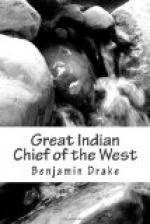[Illustration: Council ground at prairie du Chiens]
In the early part of the year 1828, the President of the United States, appointed Governor Cass and Colonel Pierre Menard, to treat with certain tribes of Indians for the cession of what is called the “mineral region” lying on the Mississippi, south of the Wisconsin. The commissioners arrived at Green Bay late in the summer of that year, and on the 25th of August, made a temporary agreement with the Indians, by which the whites were allowed to occupy the country where the lead mines were worked; and in the ensuing year a treaty was to be held with the Indians for the purchase of the mineral country: in the mean time, no white was to cross a certain line, described in said agreement, to dig for ore; and finally the Indians were paid twenty thousand dollars in goods, for the trespasses already committed on their lands by the miners. This agreement was ratified by the President and senate of the United States on the 7th January, 1829. Soon after President Jackson came into office in 1829, he appointed General McNeil of the army, to fill the place of Governor Cass in the said commission, which was to meet at St. Louis and under the agreement above described, proceed to the mineral region, to effect by treaty, its purchase. In consequence of some disagreement in opinion between these two commissioners, the President subsequently united with them, Caleb Atwater, Esq. of Ohio. They reached Prairie du Chien about the middle of July, where they met deputies on the part of the Winnebagoes, Chippeways, Ottowas, Pottawatimies, Sioux, Sauks, Foxes and Menominees; and on the first of August, a treaty was concluded for about eight millions of acres, extending from the upper end of Rock island to the mouth of the Wisconsin, from latitude 41 deg. 15’ to latitude 43 deg. 15’ on the Mississippi. Following the meanderings of the river the tract is about two hundred and forty miles from south to north. It extends along the Wisconsin and Fox rivers from west to east so as to give a passage across the country from the Mississippi to lake Michigan. At this treaty Keokuk and Morgan, with two hundred warriors of the Sac and Fox tribes were present, and according to the statement of one of the commissioners, rendered essential service to them, by intimidating the Winebagoes, who from some dissatisfaction, threatened to assassinate the commissioners and those associated with them.




